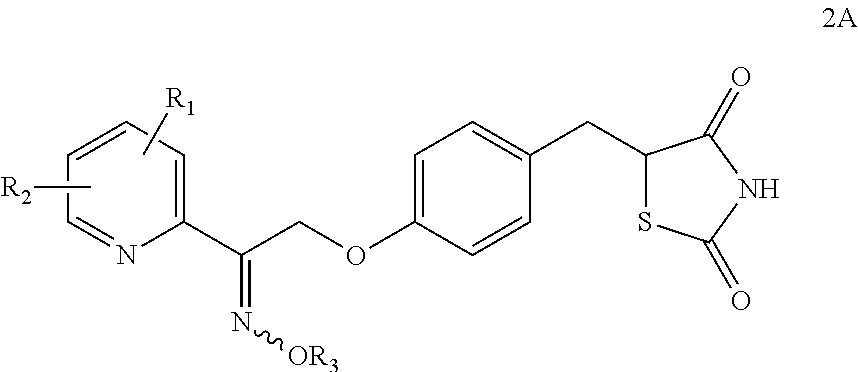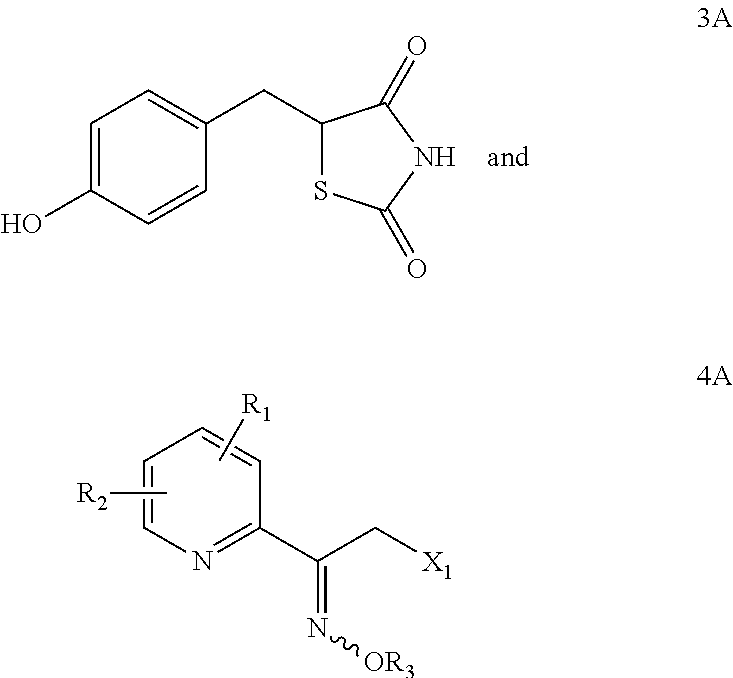Synthesis for thiazolidinedione compounds
a thiazolidinedione and compound technology, applied in the field of synthesis of thiazolidinedione compounds, can solve the problems of sodium reabsorption and other unpleasant side effects, and achieve the effects of reducing binding and activation of the nuclear transcription factor ppar, less cost of starting materials and process conditions, and safer and stabl
- Summary
- Abstract
- Description
- Claims
- Application Information
AI Technical Summary
Benefits of technology
Problems solved by technology
Method used
Image
Examples
example 1
Preparation of 1-(5-bromopyridin-2-yl)ethanone
[0247]
[0248]In a 3-neck 1000 ml round bottom flask, 2,5-dibromopyridine (10.0 g, 42.2 mmol) was dissolved in toluene (400 ml) and cooled to −40° C. (CH3CN / dry ice). 1.6 M of n-butyllithium in tetrahydrofuran (26.38 mL, 42.21 mmol) was slowly added to the cooled solution to form a deep reddish solution, which was stirred at −40° C. for 40 minutes. N,N-Dimethylacetamide (7.14 mL, 76.8 mmol) was added with no discernable change. The mixture was allowed to slowly warm to room temperature. Then, the mixture was quenched by adding 25 ml sat'd ammonium chloride. Added 100 ml H2O and extracted with EtOAc (250 ml). The organic phase was washed with water (200 ml). The combined aqueous phases were extracted with EtOAc (100 ml). The combined organic extracts were washed with brine, dried (Na2SO4), filtered and evaporated in vacuo to generate 6.31 g of a tan solid. 1H-NMR (CDCl3): δ 8.74 (d, J=1.9 Hz, 1H), 7.96 (m, 2H), 2.70 (s, 3H). HPLC: RT=3.237 ...
example 2
Preparation of (1-(5-ethylpyridin-2-yl)ethanone
[0249]
[0250]A mixture of 1-(5-bromopyridin-2-yl)ethanone (6.30 g, 31.5 mmol; Supplier=Kalexsyn; Lot=90) and [1,1′-Bis(diphenylphosphino)ferrocene]dichloropalladium(II) (560 mg, 0.76 mmol) in dioxane (120 ml) was degassed by sparging with N2 for 10 minutes. Added a solution (15% w / w) of diethyl zinc in hexane (50 ml) slowly, dropwise and heated to 50° C. The orange mixture turned dark, ultimately generating a dark orange with yellow solids as it stirred at 50° C. for 30 minutes. Allowed to cool to room temperature. The reaction mixture was partitioned between EtOAc (200 ml) and water (200 ml), and the aqueous phase was extracted 2× with EtOAc. The combined organic phases were washed with brine (500 ml), dried (Na2SO4), filtered and evaporated in vacuo to give 4.14 g brown oil. Distilled under high vac using short-path distillation apparatus. BP=55° C. @ 0.32 torr to give 2.249 g of slightly tinted oil. 1H-NMR (CDCl3): δ 8.50 (d, J=1.9 Hz...
example 3
Preparation of 22-bromo-1-(5-ethylpyridin-2-yl)ethanone hydrogen bromide
[0251]
[0252]To a stirring solution of 1-(5-ethylpyridin-2-yl)ethanone (634 mg, 4.25 mmol; Supplier=Kalexsyn; Lot=1003-TTP-112) in 33% HBr / HOAc (w / w, 5 ml) at 10° C. (water bath with a little ice) was added 0.173 ml bromine dropwise. Stirred for 1 hour at room temperature at which time the reaction appeared complete by HPLC. Added ether (5 ml) and stirred for 15 minutes. The orange solids were collected by suction filtration, washed with ether, and dried under high vac. 1.042 g orange solid. 1H-NMR (DMSO-d6): δ 9.65 (brs, 1H), 8.62 (d, J=1.9 Hz, 1H), 7.97 (m, 1H), 7.91 (d, J=2.1 Hz, 1H), 4.99 (s, 2H), 2.74 (q, J=7.5 Hz, 2H), 1.22 (t, J=7.6 Hz, 3H). HPLC: 3.747 min., 83 area % @ 2540 nm; 3.747 min., 95 area % @ 210 nm. MS (ESI—) for C9H10BrNO m / z 229.1 (M+H)+.
PUM
| Property | Measurement | Unit |
|---|---|---|
| temperature | aaaaa | aaaaa |
| affinity | aaaaa | aaaaa |
| aliphatic | aaaaa | aaaaa |
Abstract
Description
Claims
Application Information
 Login to View More
Login to View More - R&D
- Intellectual Property
- Life Sciences
- Materials
- Tech Scout
- Unparalleled Data Quality
- Higher Quality Content
- 60% Fewer Hallucinations
Browse by: Latest US Patents, China's latest patents, Technical Efficacy Thesaurus, Application Domain, Technology Topic, Popular Technical Reports.
© 2025 PatSnap. All rights reserved.Legal|Privacy policy|Modern Slavery Act Transparency Statement|Sitemap|About US| Contact US: help@patsnap.com



